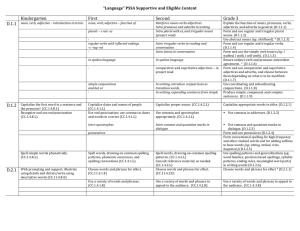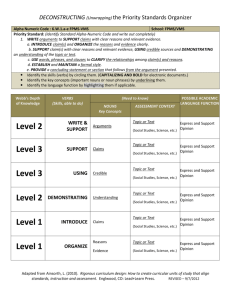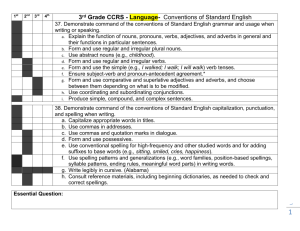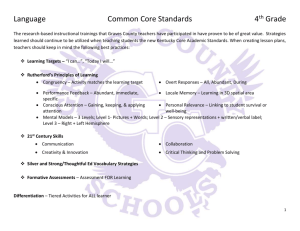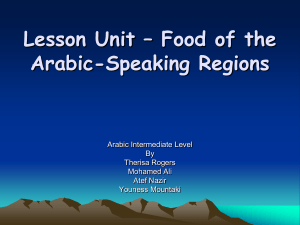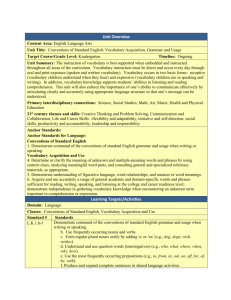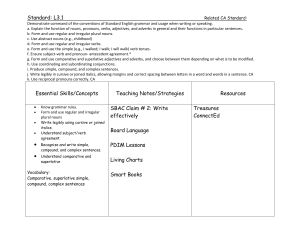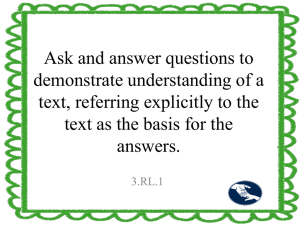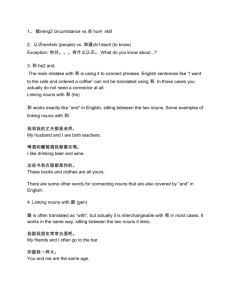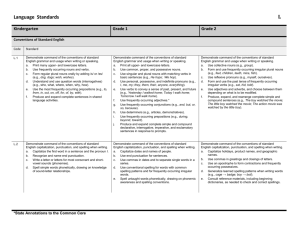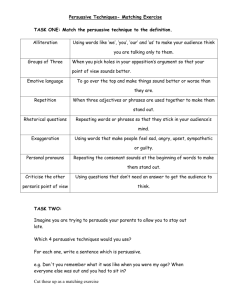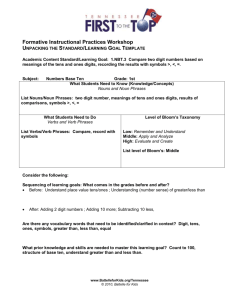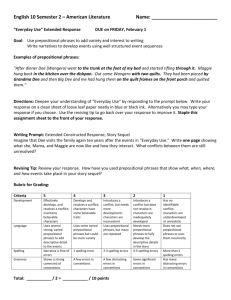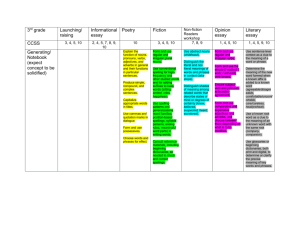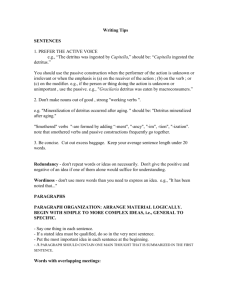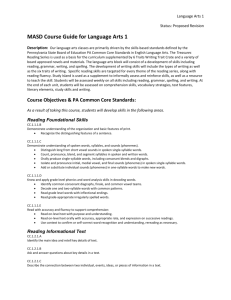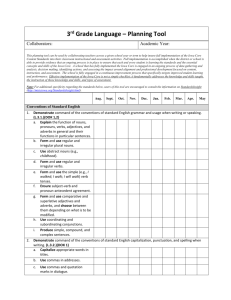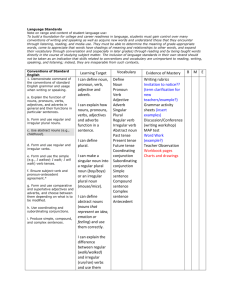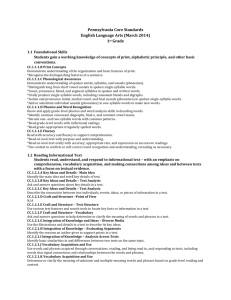Curriculum Map Appendix A
advertisement
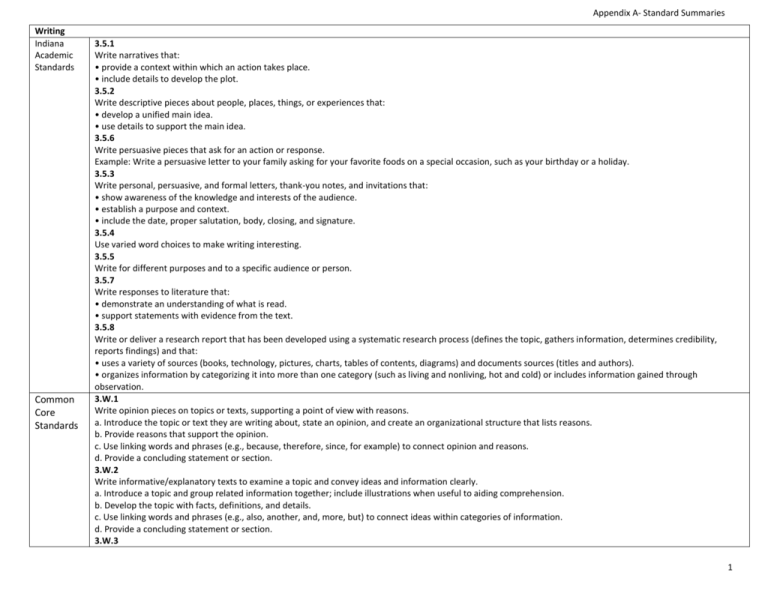
Appendix A- Standard Summaries Writing Indiana Academic Standards Common Core Standards 3.5.1 Write narratives that: • provide a context within which an action takes place. • include details to develop the plot. 3.5.2 Write descriptive pieces about people, places, things, or experiences that: • develop a unified main idea. • use details to support the main idea. 3.5.6 Write persuasive pieces that ask for an action or response. Example: Write a persuasive letter to your family asking for your favorite foods on a special occasion, such as your birthday or a holiday. 3.5.3 Write personal, persuasive, and formal letters, thank-you notes, and invitations that: • show awareness of the knowledge and interests of the audience. • establish a purpose and context. • include the date, proper salutation, body, closing, and signature. 3.5.4 Use varied word choices to make writing interesting. 3.5.5 Write for different purposes and to a specific audience or person. 3.5.7 Write responses to literature that: • demonstrate an understanding of what is read. • support statements with evidence from the text. 3.5.8 Write or deliver a research report that has been developed using a systematic research process (defines the topic, gathers information, determines credibility, reports findings) and that: • uses a variety of sources (books, technology, pictures, charts, tables of contents, diagrams) and documents sources (titles and authors). • organizes information by categorizing it into more than one category (such as living and nonliving, hot and cold) or includes information gained through observation. 3.W.1 Write opinion pieces on topics or texts, supporting a point of view with reasons. a. Introduce the topic or text they are writing about, state an opinion, and create an organizational structure that lists reasons. b. Provide reasons that support the opinion. c. Use linking words and phrases (e.g., because, therefore, since, for example) to connect opinion and reasons. d. Provide a concluding statement or section. 3.W.2 Write informative/explanatory texts to examine a topic and convey ideas and information clearly. a. Introduce a topic and group related information together; include illustrations when useful to aiding comprehension. b. Develop the topic with facts, definitions, and details. c. Use linking words and phrases (e.g., also, another, and, more, but) to connect ideas within categories of information. d. Provide a concluding statement or section. 3.W.3 1 Appendix A- Standard Summaries Write narratives to develop real or imagined experiences or events using effective technique, descriptive details, and clear event sequences. a. Establish a situation and introduce a narrator and/or characters; organize an event sequence that unfolds naturally. b. Use dialogue and descriptions of actions, thoughts, and feelings to develop experiences and events or show the response of characters to situations. c. Use temporal words and phrases to signal event order. d. Provide a sense of closure. 3.W.4 With guidance and support from adults, produce writing in which the development and organization are appropriate to task and purpose. 3.W.5 With guidance and support from peers and adults, develop and strengthen writing as needed by planning, revising, and editing. 3.W.6 With guidance and support from adults, use technology to produce and publish writing (using keyboarding skills) as well as to interact and collaborate with others. 3.W.7 Conduct short research projects that build knowledge about a topic. 3.W.8 Recall information from experiences or gather information from print and digital sources; take brief notes on sources and sort evidence into provided categories. 3.W.10 Write routinely over extended time frames (time for research, reflection, and revision) and shorter time frames (a single sitting or a day or two) for a range of discipline-specific tasks, purposes, and audiences. English Language Conventions Indiana 3.6.1 Academic Write legibly in cursive, leaving space between letters in a word, words in a sentence, and words and the edges of the paper. Standards 3.6.2 Write correctly complete sentences of statement, command, question, or exclamation, with final punctuation. Declarative, Imperative, Interrogative, Exclamatory 3.6.3 Identify and use subjects and verbs that are in agreement (we are instead of we is). 3.6.4 Identify and use past (he danced), present (he dances), and future (he will dance) verb tenses properly in writing. 3.6.5 Identify and correctly use pronouns (it, him, her), adjectives (brown eyes, two younger sisters), compound nouns (summertime, snowflakes), and articles (a, an, the) in writing. 3.6.6 Use commas in dates, locations, and addresses, and for items in a series. 3.6.7 Capitalize correctly geographical names, holidays, historical periods, and special events 3.6.8 Spell correctly one-syllable words that have blends (walk, play, blend), contractions (isn’t, can’t), compounds, common spelling patterns (qu-; changing win to winning; changing the ending of a word from -y to -ies to make a plural, such as cherry/cherries), and common homophones (words that sound the same but have different spellings, such as hair/hare). 3.6.9 Arrange words in alphabetical order.. 2 Appendix A- Standard Summaries Common Core Standards 3.L.1 Demonstrate command of the conventions of Standard English grammar and usage when writing or speaking. a. Explain the function of nouns, pronouns, verbs, adjectives, and adverbs in general and their functions in particular sentences. b. Form and use regular and irregular plural nouns. c. Use abstract nouns (e.g., childhood). d. Form and use regular and irregular verbs. e. Form and use the simple (e.g., I walked; I walk; I will walk) verb tenses. f. Ensure subject-verb and pronoun-antecedent agreement. g. Form and use comparative and superlative adjectives and adverbs, and choose between them depending on what is to be modified. h. Use coordinating and subordinating conjunctions. i. Produce simple, compound, and complex sentences. 3.L.2 Demonstrate command of the conventions of Standard English capitalization, punctuation, and spelling when writing. a. Capitalize appropriate words in titles. b. Use commas in addresses. c. Use commas and quotation marks in dialogue. d. Form and use possessives. e. Use conventional spelling for high-frequency and other studied words and for adding suffixes to base words (e.g., sitting, smiled, cries, happiness). f. Use spelling patterns and generalizations (e.g., word families, position-based spellings, syllable patterns, ending rules, meaningful word parts) in writing words. g. Consult reference materials, including beginning dictionaries, as needed to check and correct spellings. English Language Arts Academic Standards: Grade 3 3.L.3 Use knowledge of language and its conventions when writing, speaking, reading, or listening. a. Choose words and phrases for effect. b. Recognize and observe differences between the conventions of spoken and written Standard English. 3.L.4 Determine or clarify the meaning of unknown and multiple-meaning word and phrases based on grade 3 reading and content, choosing flexibly from a range of strategies. a. Use sentence-level context as a clue to the meaning of a word or phrase. b. Determine the meaning of the new word formed when a known affix is added to a known word (e.g., agreeable/disagreeable, comfortable/uncomfortable, care/careless, heat/preheat). c. Use a known root word as a clue to the meaning of an unknown word with the same root (e.g.,company, companion). d. Use glossaries or beginning dictionaries, both print and digital, to determine or clarify the precise meaning of key words and phrases. 3.L.5 Demonstrate understanding of word relationships and nuances in word meanings. a. Distinguish the literal and non-literal meanings of words and phrases in context (e.g., take steps). b. Identify real-life connections between words and their use (e.g., describe people who are friendly or helpful). c. Distinguish shades of meaning among related words that describe states of mind or degrees of certainty (e.g., knew, believed, suspected, heard, wondered). 3.L.6 Acquire and use accurately grade-appropriate conversational, general academic, and domain-specific words and phrases, including those that signal spatial and temporal relationships (e.g., After dinner that night, we went looking for them). 3
